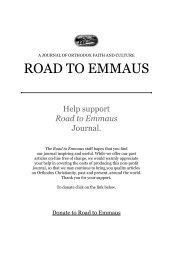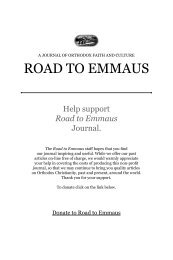RTE No 20 Interior - Road to Emmaus Journal
RTE No 20 Interior - Road to Emmaus Journal
RTE No 20 Interior - Road to Emmaus Journal
Create successful ePaper yourself
Turn your PDF publications into a flip-book with our unique Google optimized e-Paper software.
<strong>Road</strong> <strong>to</strong> <strong>Emmaus</strong> Vol. XII, <strong>No</strong>. 1 (#44)Igumen Melchisedek: We were flying. We had wings. The grace! The cells,the graves… everything. Elder Amvrosy’s grave was the only one shown <strong>to</strong> us,but we knew that all of the other elders were buried around the main church.I <strong>to</strong>ok slides of the monastery and when we returned <strong>to</strong> the seminary, I borrowedpho<strong>to</strong>s of the elders from the library and found good pre-revolutionarymaterials, particularly Optina Pustyn and Its Era by Ivan Kontzevitch,the most unique book on the his<strong>to</strong>ry of Optina. Within a week, I gave a lecture<strong>to</strong> the seminarians on the his<strong>to</strong>ry of Optina Monastery and the life ofits elders. (smiling) I’d spent half a day there, and was now speaking likean expert on Optina, but the whole experience was very close <strong>to</strong> me. It hadmade a huge impression.Four years later, in 1988, I’d finished seminary and was now a hieromonkat the Lavra. On Pentecost, the great feastday of Holy Trinity-St. SergiusLavra, during the festal dinner, Archimandrite Alexei Kutepov, the namestnik2 of the Lavra announced, “The following fathers are being sent with theblessing of Patriarch Pimen <strong>to</strong> revive Optina Pustyn: Archimandrite Evlogy,Hieromonk Theophilact, Hierodeacon Innokenty….” He ended the list withHierodeacon Pankary and myself, who’d both been on the original seminarians’visit. I’d finished seminary and had just entered the Lavra’s theologicalacademy. I wept because I had <strong>to</strong> leave the Lavra, but I also knew that Godhad prepared me for this in advance.There were two contradic<strong>to</strong>ry feelings in my soul. I was leaving St. Sergius-Holy Trinity Lavra where I’d spent four years in seminary, where I’d been<strong>to</strong>nsured, and where my spiritual father lived. It was there that I’d learned <strong>to</strong>be a monk and I’d become accus<strong>to</strong>med <strong>to</strong> the Lavra’s traditions, but when Iheard the words “Optina Monastery” quite different feelings began <strong>to</strong> appearin my soul. I unders<strong>to</strong>od that it was a great honor <strong>to</strong> be part of the revivalof such a monastery, which coincided with the celebration of the 1000-yearanniversary of the Baptism of Russia in 988.Although the Sobor of the Russian Church 3 was gathering at the Lavra forthe millennium celebration, Optina’s first namestnik, Archimandrite Evlogy,went <strong>to</strong> Optina a few days before. I went with him as I’d been given the task of2 Namestnik: A Russian term meaning “viceroy”, or “deputy,” literally in place of an appointee. Many ofthe large Russian monasteries are directly under the Patriarch of Russia, with the day-by-day running of thefoundation entrusted <strong>to</strong> a namestnik, an experienced hieromonk who takes on the role of abbot in his stead.3 Sobor: from Slavonic for “assembly” is a council of bishops gathered with other clerical and lay delegatesrepresenting the entire church.Opposite: Pilgrims at pre-revolutionary Optina, early <strong>20</strong>th century.4










